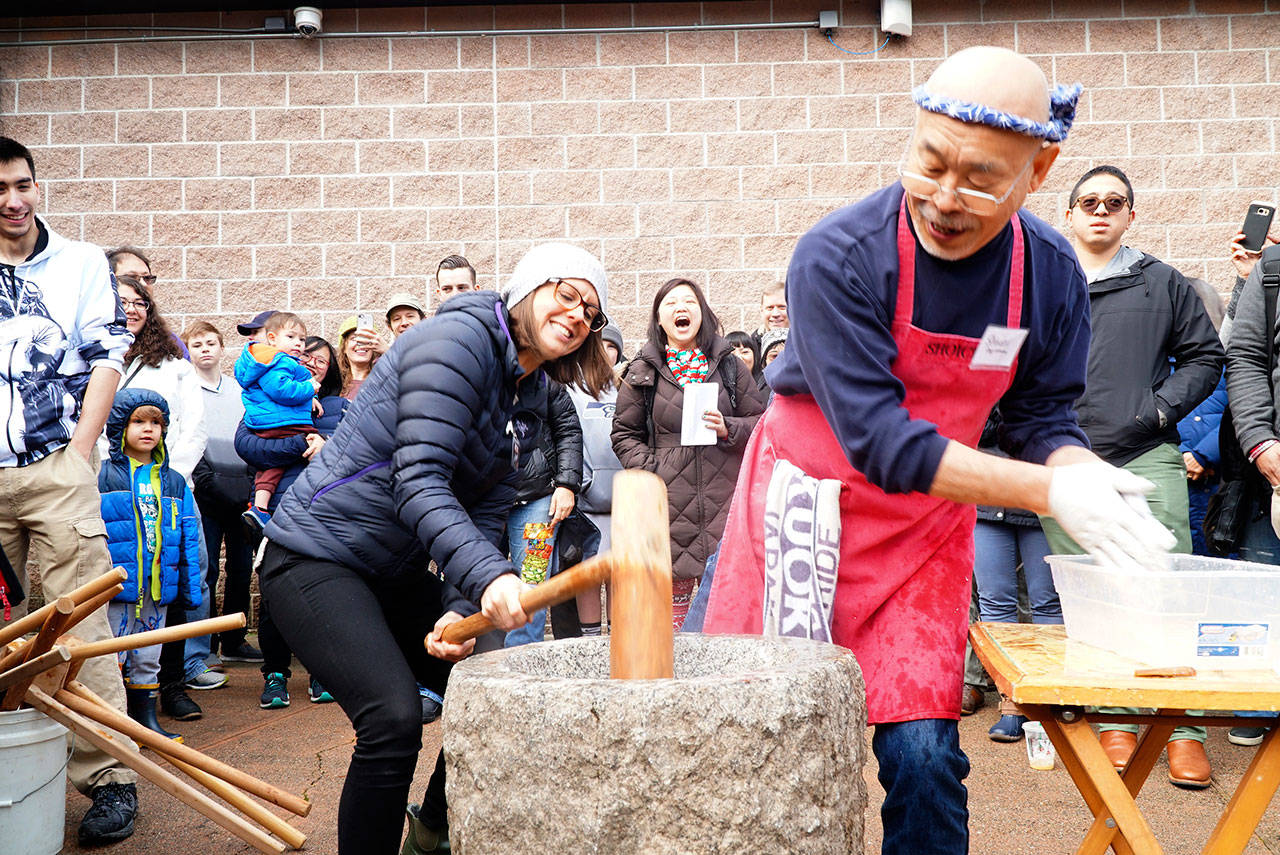The iconic Bainbridge mochi tsuki event heralded its 30th year by moving to the new, perfectly appropriate venue of Woodward Middle School last year, to which it shall return once more Saturday, Jan. 4.
The beloved island tradition, reportedly the largest of its kind in the country — and arguably the island’s most famous gathering (besides perhaps the Grand Old Fourth of July) — is right at home at Woodward, named after renowned Bainbridge Island Review editors Walt and Milly Woodward, famously the only publishers on the West Coast to openly stand against the forced relocation and internment of Japanese Americans in the wake of the attack on Pearl Harbor.
The annual mochi tsuki event, indelibly twined as it is with the story of the internment and the unique response of most islanders — protecting their neighbor’s possessions and property, calling for their release, and ultimately eagerly welcoming them home again — could thus have found few more appropriate venues.
This year’s festival will take place from 11 a.m. to 3 p.m., and feature many of the added attractions that have become synonymous with the striking (pun intended) tradition.
In terms of space, too, the new home is appropriate, as according to Bainbridge Island Japanese American Community sources the festival had systematically outgrown all previous venues — including, most recently, IslandWood — and was attended last year alone by about 3,000 people.
Things started out much more humbly.
According to BIJAC, the mochi gathering began as a small informal New Year’s celebration at the former Bainbridge Cleaners, in Winslow. It quickly grew in popularity, however, and moved to Island Center Hall. After a few years, it grew even bigger and moved again to the Filipino American Community Hall.
In 2004, IslandWood hosted their first mochi tsuki celebration, where the event was held every year since — until last January, when the move became the newest chapter in the storied history of the gathering, and the practice of making mochi itself.
For more than 1,000 years, making and eating the sweet rice treat mochi has been a celebrated New Year’s tradition in Japan, with generations of families and communities coming together to wish good health and prosperity for the new year.
Traditional mochi pounding, hand-forming mochi, origami folding and a BIJAC informational display will be featured at this year’s event, along with a special “passing of the mallet” ceremony honoring retiring “Master Mochi Pounder” and longtime unofficial face of the event Shoichi Sugiyama at noon.
The move to Woodward was made possible, according to BIJAC, thanks to a cultural grant from the city of Bainbridge Island and support from event partners Town & Country Market, Bainbridge Island’s ACE Hardware and IslandWood.
Attendees will once again get to participate in preparing batches of mochi made in the centuries-old method.
First, they’ll steam the sweet rice over an open fire and then place the cooked rice into a warm stone or concrete bowl called an usu.
Using large wooden mallets, several people (supervised by volunteers) then rhythmically pound the rice in the usu, while, with bare hands, another especially brave person (until now, most famously Sugiyama himself) swiftly moves the rice between each mallet crash.
After several minutes of vigorous pounding, the rice becomes a thick, smooth dough, called mochi.
From there the mochi is removed and guests hand-form the steaming-hot mochi into small handball-sized cakes, filling some of them with a sweet bean paste called ahn. BIJAC officials said that while arguably mochi is arguably best eaten hot and fresh, many do enjoy roasting it in the oven later and then dipping the puffy and crisp hot mochi cakes into a combination of sugar and soy sauce.
Woodward Middle School is located at 9125 Sportsman Club Road NE.
Special performances of taiko-style drumming will take place at noon and 2 p.m.
Learn more by visiting www.bijacevents.org.



